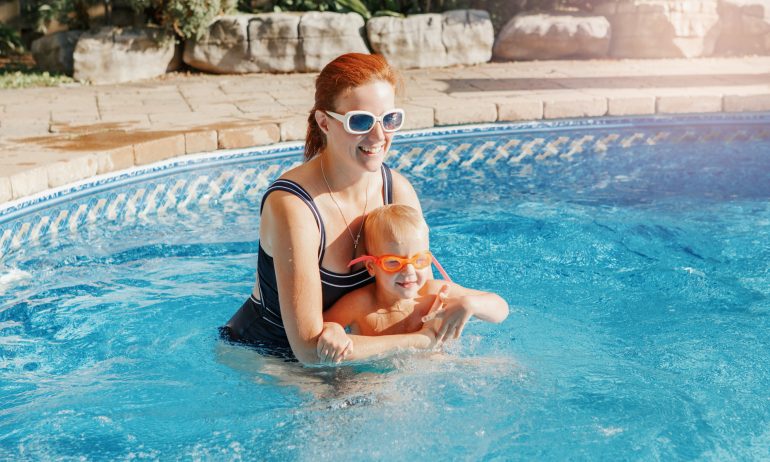Pool Financing 101: How to Pay For a Pool in 2024

Many or all of the products featured here are from our partners who compensate us. This influences which products we write about and where and how the product appears on a page. However, this does not influence our evaluations. Our opinions are our own. Here is a list of our partners and here's how we make money.
On a hot summer day, a dip into a backyard pool can feel priceless. But installing that swimming pool comes with a price tag.
The average cost of an inground pool is around $65,000, according to the home services website Angi, but you can spend more than $100,000, depending on the size of the pool, building materials and whether you include additional features.
Cash is an interest-free way to pay for your backyard oasis, but saving up could take years. Instead, you may choose to borrow funds for the project. The best pool financing option depends on the estimated cost as well as your home equity, credit and income.
on SoFi's website
on SoFi's website
5 inground pool financing options
1. Personal loans
Personal loans are often unsecured, meaning you don’t pledge collateral like a house or car to borrow the money. Instead, lenders consider your creditworthiness when deciding whether to lend to you. You get a personal loan in a lump sum and repay it in monthly installments, usually over two to seven years.
Personal loan amounts are $1,000 to $100,000, and annual percentage rates range from 6% to 36%, but your specific loan offer depends on information like your credit score, credit history, income and other debts. The lowest rates and largest loans usually go to borrowers with high incomes, low debt and good or excellent credit (690 or higher score).
When personal loans are best: Consider a personal loan if you don’t have enough equity in your home to cover the cost of a pool. It may also be a good choice if you need the funds fast because personal loans are often funded within a day or two of approval. And because loan amounts are fixed, they work when you have a firm cost estimate for your pool.
Pros and cons of financing an inground pool with a personal loan
No collateral required.
Funding is fast.
Fixed payments help you budget.
Rates are likely higher than home equity financing.
Can’t be used for pools that cost over $100,000.
Short repayment terms may require large monthly payments.
2. Home equity loans
A home equity loan is a second mortgage that you borrow in a lump sum and repay in fixed monthly installments.
With a home equity loan, you can borrow around 85% of your home’s value, minus what you owe on your mortgage. These loans have repayment terms of up to 30 years, and average rates start around 8%.
When home equity loans are best: Home equity loans work best if you have enough equity to pay for the new pool and want a fixed APR and payments. This option requires a firm cost estimate because you can only borrow once.
» MORE: Compare home equity loan lenders
Pros and cons of financing an inground pool with a home equity loan
Fixed payments help you budget.
Often lower credit and income requirements than a personal loan.
Interest is tax deductible.
Your home is collateral for the loan.
Underwriting and appraisal may delay pool installation.
3. Home equity lines of credit
A home equity line of credit (HELOC) is an open credit line that you draw from as needed during the pool installation. You can make interest-only payments during the “draw period,” which is usually the first 10 years. After that, you repay the amount borrowed for up to 20 years.
You can usually borrow up to 85% of the home’s value, minus what you owe on the mortgage. Average APRs start around 8%, but the rate varies during the loan’s lifetime.
When home equity lines of credit are best: A HELOC’s flexibility makes it a good choice if you’re concerned about unexpected expenses or if the cost estimate could change.
Pros and cons of financing an inground pool with a HELOC
Borrow-as-you-need structure leaves room for add-on expenses.
Low rates and long repayment terms keep monthly payments low.
Often lower credit and income requirements than a personal loan.
Interest is tax deductible.
Variable rates mean interest costs may increase during the loan’s lifetime.
Fluctuating payments may make budgeting difficult.
Underwriting and appraisal may delay pool installation.
Your home is collateral for the loan.
4. Cash-out refinancing
With a cash-out refinance, you get a new mortgage that’s larger than your current one. You use the new loan to pay off the old one and cover the swimming pool with the extra cash.
The loan amount can be up to 90% of your home’s value, minus what you owe on the mortgage. Because you’re replacing the old mortgage, you’ll have a new rate and repayment term. Common mortgage repayment terms are 15 and 30 years, and rates often start from 7%.
When cash-out refinancing is best: Cash-out refinancing works best if you need a large loan for a major pool installation. Ideally, you also get a lower mortgage rate than your previous one.
Pros and cons of cash-out refinancing for an inground pool
A potentially lower mortgage rate.
Often lower credit and income requirements than a personal loan.
Interest on the cashed-out amount is tax deductible.
Your home is collateral for the loan.
Underwriting and appraisal may delay pool installation.
Closing costs are deducted from the loan proceeds.
5. Contractor financing
Some pool installation companies and contractors offer unsecured financing through a third-party lender. Amounts, rates and terms vary by company, but you could borrow up to $200,000. Repayment terms are up to 30 years and rates start around 5%.
This type of financing is usually offered in person after you and the contractor have agreed on a budget, but it’s smart to take a day or two to compare other options.
When contractor financing is best: This choice is best if it’s the lowest-rate option with repayment terms that fit your budget. It also works well if you want to start right away, because approval can be fast.
Pros and cons of using contractor financing for an inground pool
Funding is fast.
No collateral.
High loan amounts can pay for expensive pools.
Long repayment terms keep monthly payments low.
Rates may be higher than home equity options.
Not all contractors offer financing.
Interest is not tax deductible.
Steps to finance an inground pool
Determine the pool’s cost. Get quotes from contractors and decide how much you’ll need to borrow. Personal and home equity loans come in a lump sum, so you will need a firm estimate to apply for the correct amount.
Compare financing options. Once you have a solid cost estimate, compare loan options up to that amount. For example, if the pool will cost more than you can borrow in equity, then a personal loan may be a better option.
Compare rates. After you’ve chosen the financing option with the right loan amount and repayment structure, compare lenders to find the lowest rate. Many personal loan lenders will let you pre-qualify online to see prospective rates and monthly payments.
Make a repayment plan. Calculate your monthly pool loan payments and see if they fit in your budget. Plan to pay on time each month over the entire loan term.
Apply. Once you’ve chosen a lender, submit an application. This step will usually trigger a hard credit pull, which will cause your credit score to dip temporarily.
How much do inground pools cost?
Installing an inground pool can cost from $44,000 to $86,000, according to Angi, which connects homeowners with home service professionals. The cost depends on the materials used to build the pool, the size and depth and whether you add other features like a waterfall or diving board.
Your financing options narrow as you firm up the cost estimate. For example, you may consider contractor or home equity financing if the inground pool costs more than $100,000.
Ongoing costs to consider
Your monthly loan payment isn’t the only cost you’ll need to manage once your pool is installed. Cleaning, maintenance and insurance are additional costs to consider.
Cleaning: If you’re not cleaning the pool yourself, you’ll want to budget for regular cleaning during the pool season. This service can cost between $80 to $200 per week, according to Angi.
Maintenance: Your new pool may also require water level checks, repairs and electricity costs. The costs to maintain your pool can range from $3,000 to $5,000 annually.
Insurance: Adding a pool to the backyard can increase the cost of your homeowner’s liability insurance. The cost can be an additional $50 to your premium annually and depends on factors like your location, insurance provider and home value.
on NerdWallet


